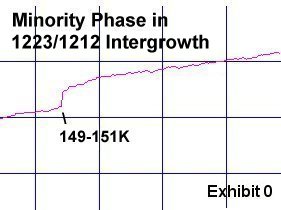
150K superconductivity signature first observed in September 2005.
Patent Claim Filed to Establish
150K High-Tc
"Congratulations. Excellent job!"
- Dr. hab Wojciech Grochala, Ph.D., D.Sc., Group Leader
Laboratory of Technology of Novel Functional Materials, University of Warsaw
"Good luck with the patent filing. We need to search for novel materials."
- Dean Peterson, Director, Superconductivity Technology Center,
Los Alamos National Laboratory
31 May 2006
Superconductors.ORG
Superconductors.ORG has filed a
claim with the U.S. Patent and Trademark Office
asserting that the compound InSnBa4Tm4Cu6O18+ has a critical superconducting
transition temperature (Tc) near 150 Kelvin when the lattice structure forms as a 1234/1212 intergrowth. If confirmed, this would establish a new record for high Tc, eclipsing
the old mark of 138K set over 13 years ago.
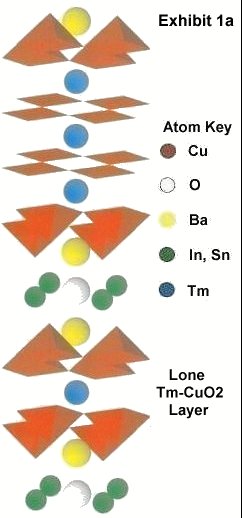 |
The 1234/1212 intergrowth structure (shown at left) will not form stoichiometrically.
So an indirect method was employed to identify the compound and support the patent claim.
Specifically:
1. The parent compound InSnBa4Tm3Cu5O16+ was found to have four superconducting
phases above 77K (see exhibits 2a & 2b below). They appear as sharp resistive transitions near:
87K (<3% by volume)
91K (<3% by volume)
113K (the majority phase)
150K (<3% by volume)
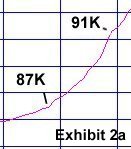 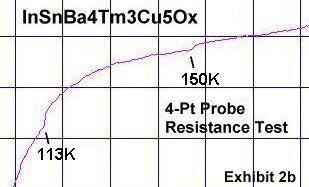
|
2. Through trial and error, the 150K minority phase was found to appear ONLY when 3 thulium and 5 copper
atoms were part of the target stoichiometry. "Even" numbers of thulium and copper atoms - such as Tm4Cu6 - failed to produce the 150K phase.
This suggests a lone Tm-CuO2 layer is required in each unit cell for the 150K phase to form.
3. Increasing planar weight disparity in the copper-oxides has previously been found to boost Tc
(Exhibit 3 below and prior art). Thus, with one CuO2 plane established (above item 2), all that is required to achieve planar
weight disparity is for multiple CuO2 planes to be present in the other (alternating) layers.
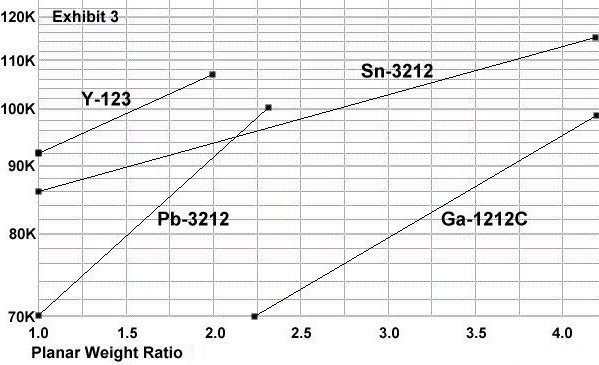
4. When free (unreacted) Tm and Cu are present in the bulk, they will couple and append the parent 1223/1212 structure with additional
Tm-CuO2 planes, creating larger unit cells with roughly equal amounts of 1223 and 1234/1212 structures resulting (see below Exhibit 1b).
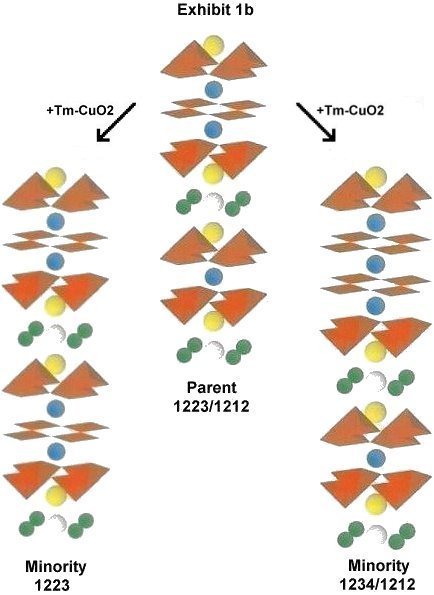
5. Excluding the 91K phase (since it is likely the known superconductor Tm-123), there are indeed two remaining minority phases
of roughly equal volume: the 87K phase and the 150K phase. Of these two, 87K was found by synthesis and
testing to be the Tc of InSnBa4Tm4Cu6O18+ with 1223 structure (see Exhibit 4 below). Ergo, the remaining 1234/1212 structure predicted
in item 4 must be the 150K phase.
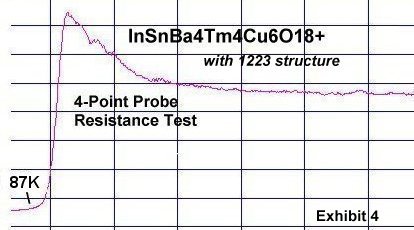
6. This conclusion is buttressed by the below log graph (Exhibit 5) which shows Tc-vs-planar weight ratio.
Extrapolating to the point where the planar weight ratio is 1234/1212 for Tm-CuO2 planes, we arrive
within one degree of the observed 150K critical temperature.
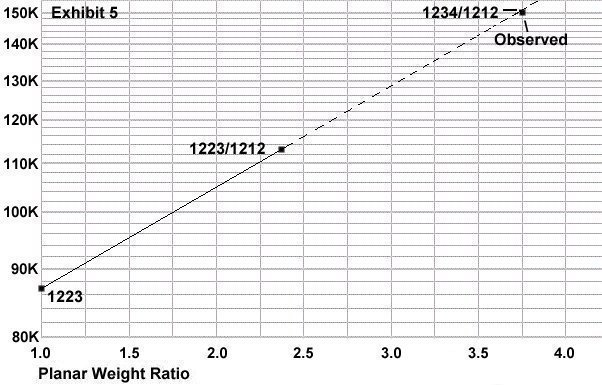
In summation:
150K superconductivity has been observed in - AND ONLY IN - an intergrowth In-Sn-Tm copper-oxide that has a single
Tm-CuO2 plane in every other layer. This suggests that the 150K phase uses planar weight disparity as the mechanism behind its very high Tc.
When extra Tm and Cu exist in the parent compound, two non-Tm123 minority phases will result.
One of these two phases was identified by synthesis and testing, leaving the remaining 1234/1212 phase - the one
with the greater planar weight disparity - to be the 150K material.
This conclusion is supported by a log plot of Tc-vs-planar weight ratio.
Analyzing the characteristics of this material:
1. Not only is the planar weight ratio high, but the percentage of total unit cell weight that the PWD layers
represent is very high.
2. The unit cell size is near ideal at 16 metal layers.
3. The insulating layers are rich in holes to complement the heavy electron doping of the CuO2 planes.
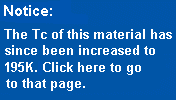
RESEARCH NOTE: Tm-copper-oxides have been found to be strongly hygroscopic.
All tests should be performed immediately after annealing.
- E. Joe Eck
© 2006 Superconductors.ORG
Patent Pending #US60/809,267
All rights reserved.
 BACK to "News" page at Superconductors.ORG
BACK to "News" page at Superconductors.ORG










 BACK to "News" page at Superconductors.ORG
BACK to "News" page at Superconductors.ORG